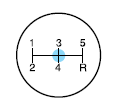Ford Escape: Manual transmission operation (if equipped)
Using the clutch
Manual transmission vehicles have a starter interlock that prevents cranking the engine unless the clutch pedal is fully pressed.
To start the vehicle:
1. Make sure the parking brake is fully set.
2. Press the clutch pedal to the
floor, then put the gearshift lever in
the neutral position.
3. Start the engine.

4. Press the brake pedal and move
the gearshift lever to the desired
gear; 1 (First) or R (Reverse).
5. Release the parking brake, then slowly release the clutch pedal while
slowly pressing on the accelerator.
During each shift, the clutch pedal must be fully pressed to the floor.
Make sure the floor mat is properly positioned so it doesn’t interfere with the full extension of the clutch pedal.
Failure to fully press the clutch pedal to the floor may cause increased shift efforts, prematurely wear transmission components or damage the transmission.
Do not drive with your foot resting on the clutch pedal or use the clutch pedal to hold your vehicle at a standstill while waiting on a hill. These actions will severely reduce the life of the clutch and could nullify a clutch warranty claim.
Recommended shift speeds
Upshift according to the following charts for best fuel economy:

Reverse
Make sure that your vehicle is at a complete stop before you shift into R (Reverse). Failure to do so may damage the transmission.
1. Hold the clutch pedal down and
move the gearshift lever into the
neutral position.
2. From the neutral position, move
the gearshift lever all the way to the
right, then move it down into the R
(Reverse) position.

Note: The gearshift lever can only be moved into R (Reverse) by moving it from left of 3 (Third) and 4 (Fourth) before shifting into R (Reverse). This is a lockout feature that protects the transmission from accidentally being shifted into R (Reverse) from 5 (Fifth).
If R (Reverse) is not fully engaged, press the clutch pedal down and return the gearshift to the neutral position. Release the clutch pedal for a moment, then press it down and shift to R (Reverse) again.
Parking your vehicle
1. Apply the brake and shift into the neutral position.
2. Fully apply the parking brake, hold the clutch pedal down, then shift
into 1 (First).
3. Turn the ignition off.
![]() WARNING: Do not park your vehicle in Neutral, it may move
unexpectedly and injure someone. Use 1 (First) gear and set the
parking brake fully.
WARNING: Do not park your vehicle in Neutral, it may move
unexpectedly and injure someone. Use 1 (First) gear and set the
parking brake fully.
See also:
Indicator lamps
Turn-signal indicator lamps/Hazard
warning indicator lamps
These indicator lamps blink on and off when a turn-signal lamp is operating.
NOTE:
● If the blinking is too fast, the cause may be a blown lamp bulb or a faulty turn-signal
conn ...
Vehicle load limit
Tire and loading information label The tire label located on the driver's door
sill gives the original tire size, cold tire pressures recommended for your vehicle,
the number of people that can be in your vehicle and vehicle capacity weight ...

 Automatic transmission operation (if equipped)
Automatic transmission operation (if equipped)